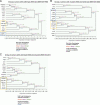Novel application of structural equation modeling to correlation structure analysis of CpG island methylation in colorectal cancer
- PMID: 21037082
- PMCID: PMC2993288
- DOI: 10.2353/ajpath.2010.100361
Novel application of structural equation modeling to correlation structure analysis of CpG island methylation in colorectal cancer
Abstract
The CpG island methylator phenotype (CIMP-high, CIMP1) is a distinct phenotype associated with microsatellite instability (MSI) and BRAF mutation in colon cancer. Recent evidence suggests the presence of KRAS mutation-associated CIMP subtype (CIMP-low, CIMP2). We used cluster analysis, principal component analysis (PCA), and structural equation modeling (SEM), a novel strategy, to decipher the correlation structure of CpG island hypermethylation. Using a database of 861 colon and rectal cancers, DNA methylation at 16 CpG islands [CACNA1G, CDKN2A (p16/ink4a), CHFR, CRABP1, HIC1, IGF2, IGFBP3, MGMT, MINT-1, MINT-31, MLH1, NEUROG1, p14 (CDKN2A/arf), RUNX3, SOCS1, and WRN] was quantified by real-time PCR. Tumors were categorized into three groups: Group 1 with wild-type KRAS/BRAF (N = 440); Group 2 with mutant KRAS and wild-type BRAF (N = 308); and Group 3 with wild-type KRAS and mutant BRAF (N = 107). Tumors with mutant KRAS/BRAF (N = 6) were excluded. In unsupervised hierarchical clustering analysis, all but six markers (CACNA1G, IGF2, RUNX3, MGMT, MINT-1, and SOCS1) were differentially clustered with CIMP-high and CIMP-low according to KRAS and BRAF status. In SEM, the correlation structures between CIMP, locus-specific CpG island methylation, and MSI differed according to KRAS and BRAF status, which was consistent with PCA results. In conclusion, KRAS and BRAF mutations appear to differentially influence correlation structure of CpG island methylation. Our novel data suggest two distinct perturbations, resulting in differential locus-specific propensity of CpG methylation.
Figures


Similar articles
-
Comprehensive biostatistical analysis of CpG island methylator phenotype in colorectal cancer using a large population-based sample.PLoS One. 2008;3(11):e3698. doi: 10.1371/journal.pone.0003698. Epub 2008 Nov 12. PLoS One. 2008. PMID: 19002263 Free PMC article.
-
TGFBR2 mutation is correlated with CpG island methylator phenotype in microsatellite instability-high colorectal cancer.Hum Pathol. 2007 Apr;38(4):614-20. doi: 10.1016/j.humpath.2006.10.005. Epub 2007 Jan 31. Hum Pathol. 2007. PMID: 17270239
-
CpG island methylator phenotype, microsatellite instability, BRAF mutation and clinical outcome in colon cancer.Gut. 2009 Jan;58(1):90-6. doi: 10.1136/gut.2008.155473. Epub 2008 Oct 2. Gut. 2009. PMID: 18832519 Free PMC article.
-
Prognostic significance of CDKN2A (p16) promoter methylation and loss of expression in 902 colorectal cancers: Cohort study and literature review.Int J Cancer. 2011 Mar 1;128(5):1080-94. doi: 10.1002/ijc.25432. Int J Cancer. 2011. PMID: 20473920 Free PMC article. Review.
-
Molecular and prognostic heterogeneity of microsatellite-unstable colorectal cancer.World J Gastroenterol. 2014 Apr 21;20(15):4230-43. doi: 10.3748/wjg.v20.i15.4230. World J Gastroenterol. 2014. PMID: 24764661 Free PMC article. Review.
Cited by
-
LINE-1 hypomethylation in normal colon mucosa is associated with poor survival in Chinese patients with sporadic colon cancer.Oncotarget. 2015 Sep 15;6(27):23820-36. doi: 10.18632/oncotarget.4450. Oncotarget. 2015. PMID: 26172297 Free PMC article.
-
Molecular Features of the Serrated Pathway to Colorectal Cancer: Current Knowledge and Future Directions.Gut Liver. 2021 Jan 15;15(1):31-43. doi: 10.5009/gnl19402. Gut Liver. 2021. PMID: 32340435 Free PMC article. Review.
-
The role of Pcdh10 in neurological disease and cancer.J Cancer Res Clin Oncol. 2023 Aug;149(10):8153-8164. doi: 10.1007/s00432-023-04743-w. Epub 2023 Apr 14. J Cancer Res Clin Oncol. 2023. PMID: 37058252 Free PMC article. Review.
-
Host Transcriptional Regulatory Genes and Microbiome Networks Crosstalk through Immune Receptors Establishing Normal and Tumor Multiomics Metafirm of the Oral-Gut-Lung Axis.Int J Mol Sci. 2023 Nov 23;24(23):16638. doi: 10.3390/ijms242316638. Int J Mol Sci. 2023. PMID: 38068961 Free PMC article. Review.
-
Clinicopathologic Risk Factor Distributions for MLH1 Promoter Region Methylation in CIMP-Positive Tumors.Cancer Epidemiol Biomarkers Prev. 2016 Jan;25(1):68-75. doi: 10.1158/1055-9965.EPI-15-0935. Epub 2015 Oct 28. Cancer Epidemiol Biomarkers Prev. 2016. PMID: 26512054 Free PMC article.
References
-
- Teodoridis JM, Hardie C, Brown R. CpG island methylator phenotype (CIMP) in cancer: causes and implications. Cancer Lett. 2008;268:177–186. - PubMed
-
- Weisenberger DJ, Siegmund KD, Campan M, Young J, Long TI, Faasse MA, Kang GH, Widschwendter M, Weener D, Buchanan D, Koh H, Simms L, Barker M, Leggett B, Levine J, Kim M, French AJ, Thibodeau SN, Jass J, Haile R, Laird PW. CpG island methylator phenotype underlies sporadic microsatellite instability and is tightly associated with BRAF mutation in colorectal cancer. Nat Genet. 2006;38:787–793. - PubMed
-
- Nosho K, Irahara N, Shima K, Kure S, Kirkner GJ, Schernhammer ES, Hazra A, Hunter DJ, Quackenbush J, Spiegelman D, Giovannucci EL, Fuchs CS, Ogino S. Comprehensive biostatistical analysis of CpG island methylator phenotype in colorectal cancer using a large population-based sample. PLoS ONE. 2008;3:e3698. - PMC - PubMed
-
- Samowitz W, Albertsen H, Herrick J, Levin TR, Sweeney C, Murtaugh MA, Wolff RK, Slattery ML. Evaluation of a large, population-based sample supports a CpG island methylator phenotype in colon cancer. Gastroenterology. 2005;129:837–845. - PubMed
Publication types
MeSH terms
Substances
Grants and funding
LinkOut - more resources
Full Text Sources
Medical
Research Materials
Miscellaneous

